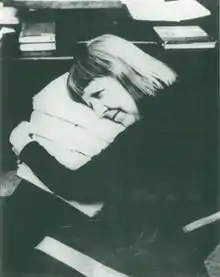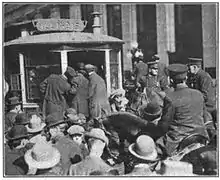Marguerite Young
Marguerite Vivian Young (August 26, 1908 – November 17, 1995) was an American novelist and academic. She is best known for her novel Miss MacIntosh, My Darling. In her later years, she was known for teaching creative writing and as a mentor to young authors. "She was a respected literary figure as well as a cherished Greenwich Village eccentric."[1] During her lifetime, Young wrote two books of poetry, two historical studies, one collection of short stories, one novel, and one collection of essays.[1][2][3][4][5]
Marguerite Young | |
|---|---|
 Marguerite Young with MS of Miss MacIntosh, My Darling | |
| Born | Marguerite Vivian Young August 26, 1908 Indianapolis, Indiana, United States |
| Died | 17 November 1995 (aged 87) Indianapolis, Indiana, United States |
| Occupation | Poet, novelist, biographer, professor |
| Nationality | American |
| Alma mater | Butler University B.A. University of Chicago M.A. University of Iowa Ph.D. |
| Notable works | Angel in the Forest Miss MacIntosh, My Darling Harp Song for a Radical |
Background

Young was born in Indianapolis, Indiana.[1] Through her father, Chester Ellis Young, she was a collateral descendant of Brigham Young, and by her mother, Fay Herron Knight, she was a direct descendant of John Knox.[1][4]
Young's parents separated when she was very young, and she and her sister, Naomi, were brought up by their maternal grandmother, Marguerite Herron Knight, who was convinced the child Marguerite was the reincarnation of her dead cousin, Little Harry.[6] Her grandmother nurtured Young's love of literature.
Career
Education
Young studied at Butler University in Indianapolis, receiving a BA in French and English. She then attended the University of Chicago, auditing Thornton Wilder's writing class at his invitation.[1][2] She also attended the University of Iowa.
In 1936, she earned her MA in Elizabethan and Jacobean Literature. She wrote her master's thesis on Euphues: The Anatomy of Wit by John Lyly (1578).[1][2]
While attending the University of Chicago, Young had a part-time position reading Shakespeare to Minna K. Weissenbach. A patron of Edna St. Vincent Millay, Weissenbach was sometimes known as "the opium lady of Hyde Park" and she became the inspiration for the Opium Lady in Young's Miss MacIntosh, My Darling. Drug-based flights of fantasy were to make their way into the novel.[1][2]
Later, Young received a Ph.D. in philosophy and English from the University of Iowa, where she taught at the prestigious Iowa Writers' Workshop.
Teaching
She briefly taught at Shortridge High School before embarking on a distinguished literary career. In New York she held a contract lectureship in English literature during the 1960s at Fordham University.
Works

Young's first book of poetry, Prismatic Ground, was published in 1937,[5] while she was teaching English at Shortridge High School in Indianapolis.[1] In that same year, she visited the commune of New Harmony, Indiana, where her mother and stepfather resided.
After her MA, she taught at an Indianapolis high school and at the University of Iowa.[1]
In 1943, she moved to New York, where she became known for her works Moderate Fable (1944 or 1945) and Angel in the Forest (1945).[1][5]
She relocated to New Harmony and spent seven years there, beginning work on Angel in the Forest, a study of utopian concepts and communities, at the same time producing Moderate Fable (1944), which won the poetry prize from the National Academy of Arts and Letters. Angel in the Forest appeared in 1945 and was well received, winning Guggenheim and Newberry Library awards.
Over the next fifty years, while maintaining an address in New York City's Greenwich Village, Young traveled extensively and was part of a wide literary circle that included Mari Sandoz, Richard Wright, Anaïs Nin, Flannery O'Connor, Marianne Hauser and Allen Tate, with whom she had an affair.[1] She also had a complex friendship with Carson McCullers and Truman Capote. She wrote articles, poetry, and book reviews while also teaching creative writing at various venues, including the New School for Social Research, Fordham University, and the Iowa Writers' Workshop.
In 1944, Scribners commissioned her to write a new work, ultimately published as the epic novel Miss MacIntosh, My Darling (1965).[5] Although she had intended to take just two years, she did not finish her novel until 1963.[5] Young described it as "an exploration of the illusions, hallucinations, errors of judgment in individual lives, the central scene of the novel being an opium addict's paradise."[4] Anaïs Nin, in The Novel of the Future, calls it "an epic American novel written in a poetic style." Miss MacIntosh, My Darling was not well received critically but developed a cult following.
Young's next project was to be a biography of Hoosier poet James Whitcomb Riley,[4][5][7] the creator of Little Orphant Annie. Her experiences in joining the protests against the Vietnam War made her turn her focus to Riley's friendship with Eugene V. Debs.[3] The digression was to occupy the rest of her life, becoming an ambitious biography of Debs, the union organizer who evolved into the first Socialist candidate for President of the United States (1904, 1908, 1912, 1920). She projected a three-volume epic history of the people, through Debs's battles for workers rights and the development of the Locomotive Firemen's workers union.[1] Harp Song for a Radical: The Life and Times of Eugene Victor Debs remained unfinished at the time of her death.[5]
Part I, “Prelude in a Golden Key,” portrays Swiss agnostic Wilhelm Weitling’s cross-country tour of the pioneer utopian communities built during the settlement of the western United States. He visits the Mormon communities in Nauvoo, Missouri and Salt Lake City, Utah; the Shakers; the Amish communities in Pennsylvania; the Oneida community; the Icarians; the Rappites, and many other settlements in the wilderness. Through this perspective Young establishes that this nation was founded and settled on the principles of communal ownership and mutual assistance. In Part II of Harp Song for a Radical, Young establishes that Eugene Debs was the catalyst through which these principles became the basic tenets of the labor movement in the nineteenth and twentieth centuries.
During Marguerite Young's final illness, her unfinished manuscript was compiled by Marilyn Hamilton and Suzanne Oboler and was then submitted to her publisher. After her death, the manuscript was edited by Charles Ruas to include Young's survey of utopian communities as well as her portraits of major historical figures encountered by Debs in his struggles as a labor organizer: the portraits of Mary Todd Lincoln, James Whitcomb Riley, Joe Hill, Sojourner Truth, Brigham Young, Joseph Smith and Susan B. Anthony. This edited version of Harp Song for a Radical was published by Alfred A. Knopf in 1999.
Also in her last illness, Marguerite Young returned to writing poetry. Inviting the Muses, a collection of her stories, essays, and reviews, was published by Dalkey Archive Press in 1994. Young’s papers are at the Beinecke Library, Yale University.
Works
- Prismatic Ground (1937), poems
- Moderate Fable (1944), poems
- Angel in the Forest: A Fairy Tale of Two Utopias (1945), historical study
- Miss MacIntosh, My Darling (1965), novel
- Inviting the Muses: Stories, Essays, Reviews (1994)
- Harp Song for a Radical: The Life and Times of Eugene Victor Debs (1999), historical study (posthumous)
Influences
Starting in 1975, Charles Ruas produced for Pacifica radio station WBAI in New York a year-long series of readings from Miss MacIntosh, My Darling called The Reading Experiment. The readings were by Young's contemporaries in the literary, theatre, and journalistic worlds, such as Leo Lerman, Wyatt Cooper, Osceola Archer, Marian Seldes, Ruth Ford, James Coco, Peggy Cass, and Earle Hyman. The artist Rob Wynne scored each program with concrete sound effects and atonal and harmonic music, as well as opera. The programs were distributed nationally through the Pacifica Radio Network. The series has been reissued by and is available through Clocktower Gallery's Internet station "Art on Air." Renewed interest in the book resulted in the publication in 1979 of a boxed two-volume paperback edition, with an Introduction by Anaïs Nin, by Harcourt Brace Jovanovich, as well as a two-volume paperback edition in 1993 by Dalkey Archive.
References
- Thomas, Jr., Robert McG. (20 November 1995). "Marguerite Young, 87, Author and Icon, Dies". New York Times. Retrieved 18 December 2016.
- McQuade, Molly (4 June 1995). "Famous Writers' School". Chicago Tribune. Retrieved 18 December 2016.
- Young, Marguerite (1994). Miriam Fuchs (ed.). Marguerite Young, Our Darling. Dalkey Archive Press. p. xi.
- Wakeman, John (1975). World Authors, 1950-1970: A Companion Volume to Twentieth Century Authors. Sterling. Retrieved 18 December 2016.
- Ruas, Charles (Fall 1977). "Marguerite Young, The Art of Fiction No. 66". The Paris Review. Retrieved 18 December 2016.
- Ruas, Charles (1985). Conversations with American Writers. Knopf. pp. 95 (Harry). ISBN 9780394527871. Retrieved 18 December 2016.
- Friedman, Ellen G.; Fuchs, Miriam (2014). Breaking the Sequence: Women's Experimental Fiction. Princeton University Press. pp. 82 (Ruas). ISBN 9781400859948. Retrieved 18 December 2016.
- Charles Ruas, ed. (1976–1977). "Miss Macintosh, My Darling: The Reading Experiment". Clocktower. Retrieved 18 December 2016.
- Charles Ruas, ed. (1976). "Marguerite Young Interview". Clocktower. Retrieved 18 December 2016.
- Charles Ruas, ed. (1975). "Anaïs Nin and Marguerite Young (c. 1975)". Clocktower. Retrieved 18 December 2016.
External links
- Marguerite Young Papers. Yale Collection of American Literature, Beinecke Rare Book and Manuscript Library.
External sources
- "LIFE visits Yaddo". 21 (3). Life. 15 July 1946: 110. Retrieved 18 December 2016. Cite journal requires
|journal=(help) - "Harp Song for a Radical". Stephen Shaviro. Retrieved 18 December 2016.
- "Who is Marguerite Young?". Connie Eichenlaub. Retrieved 18 December 2016.